Update! As a result of this review, Eartheasy, the North American distributor of the Lifestraw, sent me a few products to try out, and I appreciate when a company is willing to stand behind its products like that. I still feel that the Lifestraw itself is less useful than its fans make it out to be, and that the bottled version is the only version hikers and travelers should consider purchasing. I’ve given specific comments on the bottled version down below, which is worth a look as a portable filter for hiking and other outdoor activities.
As many of you may know, clean drinking water is kind of a big deal. The fact that nowadays we can get drinkable water, right at home, practically for free, is a downright revolutionary (and thoroughly recent) development, and one which remains entirely out of reach for billions throughout the world.
Enter the Lifestraw: A small, lightweight, portable, durable, relatively inexpensive filtration device that can hang around your neck like a necklace, providing you with filtered water wherever you go. It has won an endless string of accolades, and has even been called “one of the ten things that will change the way we live,” with legions of adoring fans singing its praises, swearing by its use in situations of all sorts.
Unfortunately, I think it’s bizarrely overrated.
What’s the Lifestraw?
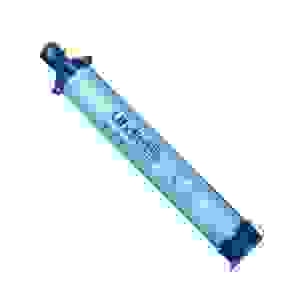
The Lifestraw is a hollow-membrane filter built into a straw. You place the straw into the water, and drink. Sucking the water up through the straw forces it through the filter, which removes 99.9999% of bacteria, and 99.9% of protozoa, down to 0.2 microns, with a filter that lasts for 1000 liters, for about $20. Not bad, right?
That’s pretty good, but on the downside, it won’t remove microscopic minerals, chemicals, or viruses.
This isn’t necessarily a deal-breaker, since most water will be fine, especially if you’re just filtering river water to avoid getting sick…but this thing was designed for the third world, with viruses all over the place, meaning you’d need iodine or other methods to eliminate the potential threat of viral diseases.
It’s certainly better than nothing, and preventing most water-borne diseases is better than preventing none. The Lifestraw was designed to provide excellent filtration at a reasonable cost, which is probably more effective than providing perfect filtration at a high cost, which could very well be too expensive to accomplish its own goals of third world disease reduction. Again, missing the viruses isn’t a deal-breaker, and it can prevent a huge number of water-borne diseases from infecting at-risk populations, but people talk about this thing like it’s the messiah of water filters.
But that’s not even the most annoying part.
The weird problem no Lifestraw review ever seems to mention
I have gone over this problem again and again in my head, looking at the endless cavalcade of glowing Lifestraw reviews, “Invention of the Century” accolades, and legions of ardent fans, and cannot fathom why no one seems to notice or care.
Take a look at the snazzy in-action shot of a guy using the Lifestraw out in the real world:
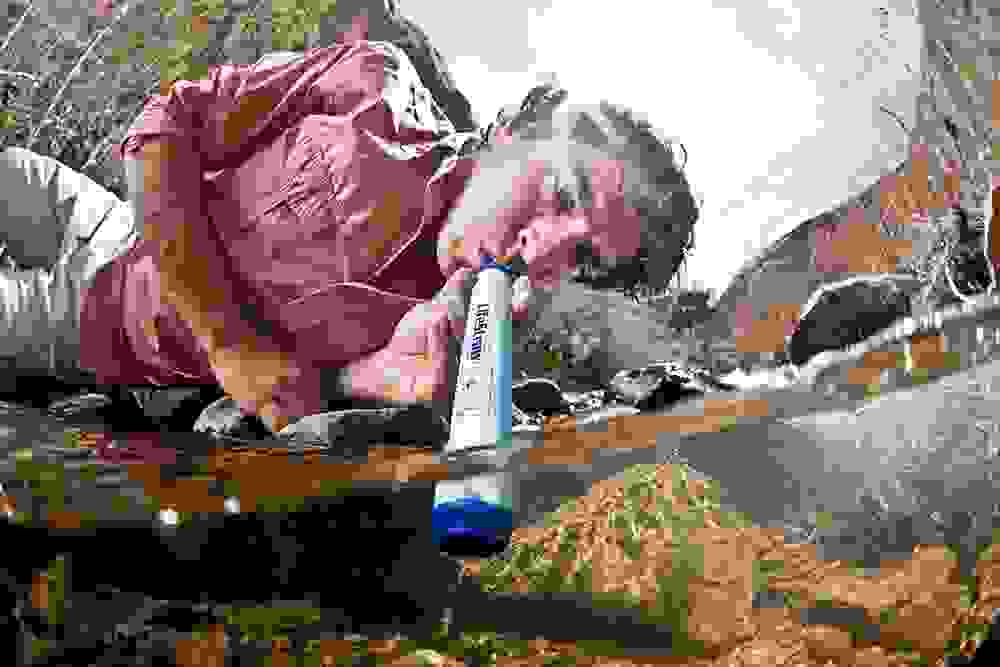
What happens when you walk away from the water?
No more water.
So if you’re heading into riverless mountains, or the desert, or a 12 hour bus ride in body-temperature heat, or any other situation in which you won’t have access to water, you’ll have to fill up a water bottle ahead of time, and whenever you want a drink of water, you have to:
- Open the bottle
- Open the Lifestraw’s top cap
- Open the Lifestraw’s bottom cap
- Stick the Lifestraw inside
- Drink
- Take it out
- Expel the remaining water
- Close the top cap
- Close the bottom cap
- Close the bottle.
And then…you’ve got a wet Lifestraw, so you’ll probably end up with wet clothes. Sexy!
People talk about how “simple” this is, as if handling three caps instead of one is somehow…simple?
On a related note, imagine traveling with this thing, and trying to fill up from a sink. You’d have to plug the sink, fill it up, wait for it to get deep enough to drink, then take a few sips, unplug the sink, and walk away. Imagine being incredibly thirsty and trying to do this in a hurry. Now imagine you’re about to get on a 12 hour bus ride through midday temperature highs, and all you had ahead of time was a quick sip from the sink, and that’s all you’ll have until the next time you get to another sink, when you’d begin the sink plug process anew. Just for one sip.
Seriously, has anyone actually used this thing?
What the Lifestraw should have been
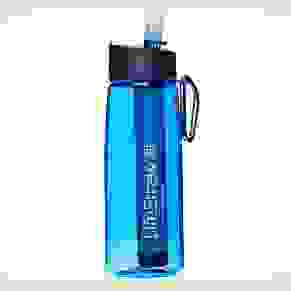
So here we finally are, at a product that’s actually recommendable. The Lifestraw Go. They took the Lifestraw and stuck it inside a water bottle, which eliminates the pointless inconvenience of only being able to drink with water nearby, or having to deal with three different caps and two separate objects for every sip.
But damn…the Lifestraw has been around since about 2005, and this bottled version only started shipping around 2013. This means that for 8 long years, nobody ever bothered asking “Dude, what if you walk away from the river but you’re still thirsty?” Sigh.
This bottled version was designed for the consumer market, which makes a lot of sense, and it’s true that shipping a million regular Lifestraws to disaster zones or poverty-stricken rural areas is logistically easier than shipping a million bottled Lifestraws, as they’d need maybe 5 or 6 times as many shipments due to the size, but damn…how does anyone use the regular one more than a few times without going crazy?
While it’s true that the original Lifestraw was designed for simplicity, portability, durability, and ease of use (and somewhat succeeds), I just can’t see many good reasons not to stick it inside a water bottle in the first place. Particularly from a consumer standpoint, the bottled version is clearly the correct answer here.
Update: I can think of ONE situation in which the straw by itself might be more useful than a bottle: Trail running, near a river. You can strap it to your leg, so it doesn’t bounce around, and you’re always near an outdoor water source, which would only need this type of filtration, and wouldn’t need a bottle.
But, ranting aside, is it a good filter? Is it a cost-effective solution to commonplace water purification needs, third world or otherwise? Could this be the one and only water purification method you employ, whether hiking in the mountains, or adventuring throughout the developing world?
Well…maybe.
Remember, it still can’t filter viruses, which is what you’d want in developing countries.
That’s not to say it’s not useful. A $35 water bottle that provides 0.2 micron filtration which lasts for 1000 liters certainly isn’t bad.
But on the other hand, you can just get the Sawyer Water Bottle, which manages 0.1 micron filtration for a guaranteed 3.7 million liters for a one-time cost of $50.
Um…tell me again, why is the Lifestraw so popular?
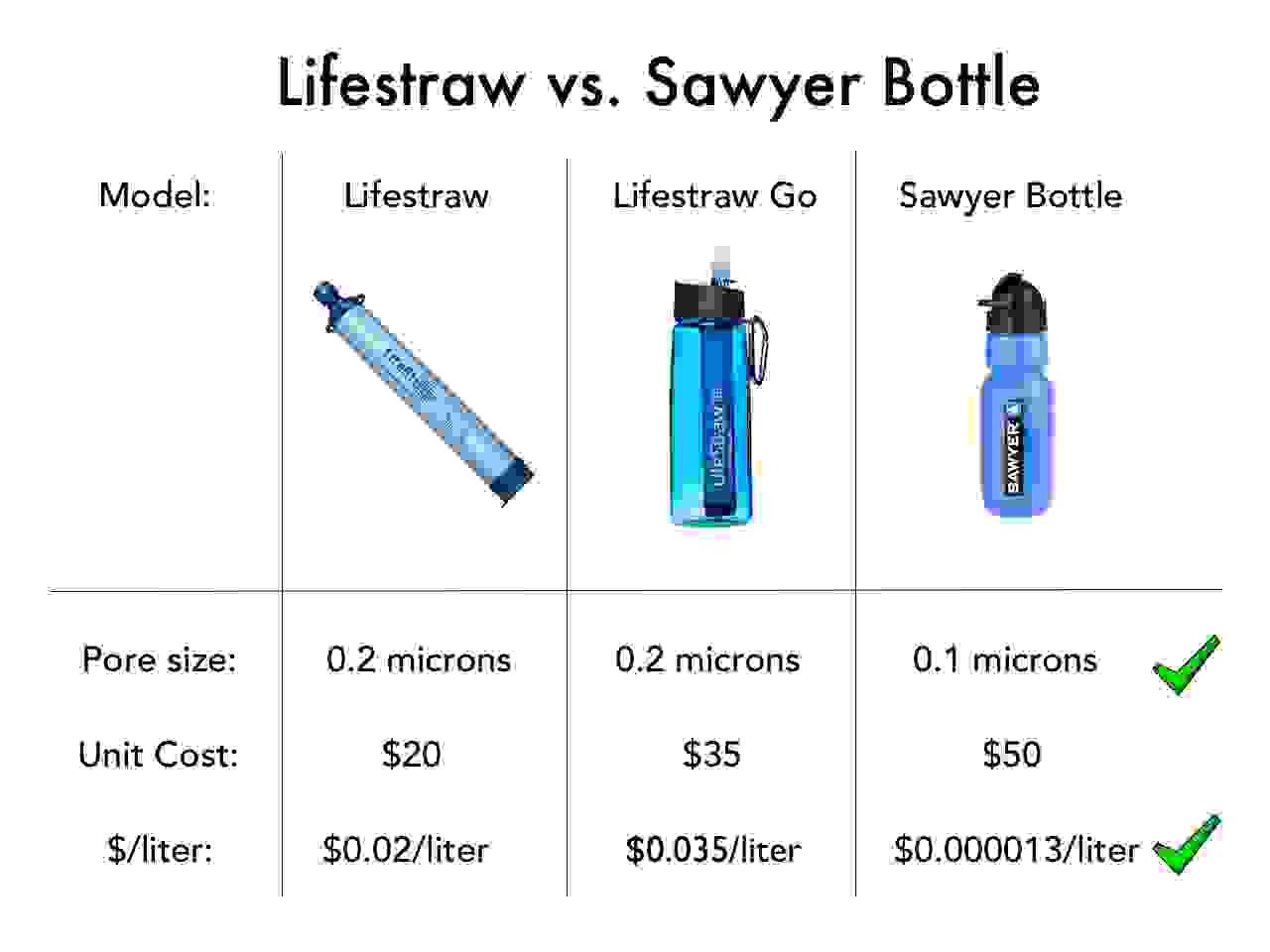
It has been claimed that the Lifestraw’s lifespan estimates are intended to be a little on the safe side, using low-quality water for all of its tests, which is good (and Sawyer’s lofty claims were put to the test, and were sadly shown to come up short, so the performance difference is likely to be smaller than what is claimed). And again, it’s not that it’s bad, and the filtration quality will probably work just fine if you’re hiking in North America, and you could supplement it with iodine tablets if you ever take it with you to Mexico, or wherever else you might want anti-viral protection. And if you’re drinking a liter of water per day, a $35 Lifestraw Go will last almost 3 years, which isn’t bad at all, and if you’re only using it for camping trips on weekends, it’ll last much longer. I also think it looks nicer than the Sawyer. So it’s definitely good; it’s just not necessarily the best, neither on filtration quality, nor on cost-effectiveness.
Update: After receiving and using the Lifestraw Go, I can say that it’s a pretty good product for hikers who plan on filling up from a river and just want a simple water bottle filter to do the job. Its filtration performance isn’t as strong as the Sawyer, nor is it as cost-effective, but it’s still effective and affordable, for non-viral filtration. Keep in mind it’s supposed to filter biological contaminants rather than chemical, meaning it’s more suited to filtering clear river water than tap water, which is more likely to have chemicals of some sort.
Two issues: Firstly, the Lifestraw Go does not use the regular Lifestraw as a replacement filter, but instead uses a slightly modified version. This means you cannot replace the filter inside the Lifestraw Go with a regular Lifestraw, and, at the moment anyway, you cannot buy just the replacement filter by itself. When your Lifestraw Go reaches the end of its life, you’ll have to buy an entirely new bottle. I expect that if the product is successful that they will offer those replacement filters by themselves, but it’s worth being aware of this issue.
Secondly, when the bottle is shut and the straw is folded down, it protrudes slightly beyond the edge of the lid, and it’s easy to get your grubby hands all over the straw when you pick up the bottle, potentially getting the straw a little dirty and thus defeating the purpose of drinking filtered water. This could be easily fixed, and I hope they do it. Second update: THEY DID!
If you think it’s for you, check it out here.
But again, neither of these devices will provide chemical or viral filtration. If you want to get rid of viruses, then you’ll need iodine tablets, or a UV light, or upgrade to a water bottle that actually gets rid of viruses, too.
What if I need serious purification?
For most people, high-quality filtration works just fine. If you’re hiking in North America or filtering tap water while traveling through modern countries, you probably don’t need virus removal to be safe. But if you’re traveling in developing countries with incredibly questionable tap water, you might want to take some extra precautions.
And yes, you can fit a whole purifier right inside a water bottle, like these do:
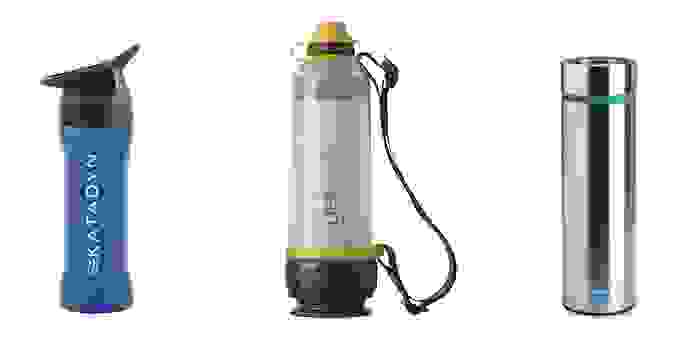
Each of these will clean out viruses, along with all the other contaminants, including chemical, that you’d want removed, providing thorough filtration beyond anything the Lifestraw can manage. Check out a thorough review of those three, including short and long term cost estimates, and suggested uses for each. They all work differently, without any objectively “best” option, so you’ll want to find a favorite that works for you. I’m currently using the GRAYL, which manages the nice trick of allowing multiple options for filtration quality as needed, and also looks nice and classy.
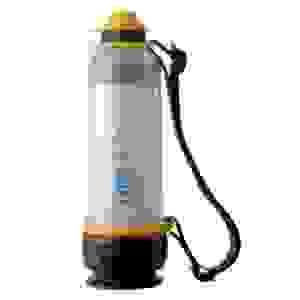
But I’d also like to highlight a close competitor to the Lifestraw, one which shares the design goal of providing high-quality, portable, durable water filtration to vulnerable populations in the third world, and which demonstrates what the Lifestraw could have been. It’s the Lifesaver Bottle, and it’s 13 times better.
The pores in the Lifestraw are 0.2 microns, whereas the pores in the Lifesaver are 0.015 microns, making them about 1/13th the size, which is small enough that viruses can’t get in. No more worrying about having to use iodine tablets.
It’s true that the Lifesaver is bigger, heavier, bulkier, and significantly more expensive (though long-term costs are actually quite good), whereas the Lifestraw was supposed to be so tiny and portable that you can take it with you wherever you go, which might actually mean it gets used more frequently by those who don’t want to bring along a bottle all the time. But…if you need a bottle anyway, and you want portable virus filtration, the Lifesaver wins.
Yet nobody seems to know it exists.
So why does everyone love the Lifestraw?!?!
Well, I don’t really know. It was even called the “Invention of the Century,” from a publication I otherwise enjoy, despite lower performance and higher long-term cost than competing options that have been on the market for years.
Again, it’s not bad, and the bottled version solves quite a bit of the silly ridiculousness of the straw-only version, but everyone adores the straw-only version, as a consumer product, which is absolutely inexplicable to me.
But I have a theory:
At $20, it’s cheaper than many other filters, and, admittedly, its filtration capability is pretty good, and a lot better than most of what I’ve seen for the same initial cost. It has a nice impulse-buy price point that gets people interested, and its unique design sets it apart in a world of filtered pitchers, faucet adapters, and so on. And when it arrives in the mail, people give it a try, drinking from a cloudy glass of water, and impressing some friends. Buyers are left happy.
And then they never use it.
Seriously. If you read the Lifestraw reviews on Amazon, you’ll see lots and lots of people talking about how great it is, who stuffed it into an emergency preparedness kit and never bothered with it again. They’re rating the product on how cool they think it is, not how practical it is in real-world use.
People actually love it so much that they videotape themselves drinking from jars of water full of feces…which is explicitly something the Lifestraw cannot handle, because water contaminated this way can easily have viruses inside, which the Lifestraw is incapable of removing. There’s a level of enthusiasm for this product that is literally dangerous.
So is the Lifestraw useful at all?
I would like to clarify that I am examining the Lifestraw from a consumer standpoint, rather than from a disaster-relief or third world disease alleviation product. It offers plenty of functionality in those situations, especially the Lifestraw Family, which is a larger (though still portable) filter intended for home use that does remove viruses. Most of my annoyance should be directed toward the overrating fanboys, who post videos of people drinking toilet water, and then resort to third-grade name-calling if anyone ever criticizes its performance or design.
So it’s certainly not horrible, particularly the bottled version, which is the only one you should bother looking at. Its filtration capability is actually quite good, and it’s pretty convenient. I just think it has been played up way too much in the media, and people salivate over it like it’s this work of art that no disaster-preparedness kit should ever be without.
Just remember that it is incapable of handling chemical and viral contamination, meaning you should only use it within a narrow band of circumstances; outdoor recreation, in North America (and similar settings), where the water you come across has neither chemicals nor viruses.
So it’s certainly worth a look, but I can’t say it’s the best. Competing products provide better filtration at a more cost-effective price, while other devices handle viruses as well, which is what you’d want in developing countries.
Check it out, but remember to…filter some of the adoration.




Have you tried the steripen? I have one this one, http://www.steripen.com/classic/ its really cool. I can see how its cost prohibitive for the third world though.
I don’t mind them, but all they do is kill the bugs in the water. They don’t filter dirt, chemicals, or other stuff. You could use the Steripen and combine it with a filter like the Sawyer, and you’d have a complete system, but I like the convenience of all-in-one designs, so I’m always on the lookout for those.
it also kills viruses and they got certification for that though. thats how tap water is also purified by the way.
the only problem is that you need perfectly clear water for this to work. if its a little blurry, use it longer. if its more than just a little blurry you need to prefilter. Clothes can do that but a full-blown filter is indeed a more practical idea in this case.
I absolutely adore that the comments section of this article is being bombarded by the same mindless fanboys you speak of in your review. Priceless!
I do so love when people generously help prove my point.
Ok I don’t normally comment on these things, but In this case I felt it deserved it. First thing to know is I believe EVERYTHING is situational. Good in some cases but not necessarily in others. Now I literately spent about half of my life in the middle of the wilderness. In particular a canyon in a high altitude desert .
My issues with your review. I enjoy Informative reviews, and your points about Virus filtration, chemical and minerals is valid. As well as for most people a sport water bottle with built in filter is more easy . However, these are all Clearly shown on Lifestraws site, and products. If you cant read how to use a simple straw before trying it, you probably shouldn’t be out hiking on mountains etc. However, I can not image why one would use a life straw in a sink. Your analogy of going from Sink to sink trying to use a straw for a drink is a bit over the top. If you have access to sinks, you most likely have access to already clean water. ( least in America) If you riding a bus for hours you probably could have bought already purified water before boarding the bus. Even in countries without clean “tap” water, your able to buy bottle water. (Europe uses almost half all bottle water made in the world, Japan, the middle east , Egypt, Vietnam, all sell clean bottle water normally far cheaper then in the states as well) Since Buses run in populated areas. So comments about using sinks to use a lifestraw, and that its difficult to open two lids tend to make the valid points you make mean less. At Least to me.
Now Im not sure how many deserts you have walked through , or how many canyons you’ve scaled, but I can tell you when you find yourself in a desert with no major water source and dig into the sand hoping your not bit or stung by something the water that does some up, you wont be able to get it into your bottle. Stick a straw into in , easy, try and fill a bottle with it… not so much. Ive tried doesn’t work well, and you end up using a shirt to absorb the water to then try and squeeze into the bottle. For me, I find round bottles difficult when compared to my army canteen, that straps to my belt, and my straw fits into it if i need to refill it from a water source. Springs in canyons also can be in areas to rocky to fit a bottle into . Once again straw works bottle didn’t, Ive tried and watched others try. So it does have uses. Not filtering virus etc is a real concern but dependent on the source of water.
Places lifestaw is easy to use over a bottle with a filter inside (that Ive needed it):
Small puddles of water ( like created from digging in dry creekbeds till water from underground seeps up)
springs , creeks , and other sources to shallow to fill a bottle without having to try and dig through rock or wait forever trying to get enough water into the bottle.
Rocky pools of water that are to small to fit a bottle into (another real issue if seen with all in ones)
Sinks to small to even fit a bulky waterbottle into or under.
If you cant find a bottle with a built in filter that has a shape to suit your needs, or built in way to carry easy.
Another note to lifestaw, they are a company that actually stands by their product, they donate alot and spend alot of time and money helping people who need it. Buy a lifestaw for you, also helps give filters for people in 3rd world areas.
You also compare lifestraw to Sawyer, but fail to mention that Sawyer does not filter Virus, metals, or chemicals either. ( at least acording to their costomer service, and web site)
The points about being able to fill up in shallow streams and puddles are valid. Those are good situations where a straw would actually be useful. My issue with the Lifestraw has more to do with the fervent enthusiasm for it, and the blatant ignorance that so many of its fans seem to have for its downsides. Yes, you can read the instructions and see that it can’t filter viruses, but so many people don’t, because all they know about it is how much everyone loves it. And even here, pointing out that it has shortcomings related to metals and viruses, results in people in the comments section shouting about how it doesn’t matter. This is completely insane. It could literally kill you, and people are shouting about it and saying it’s fine. There’s something incredibly wrong there, and that’s why I felt the need to write about it.
I used the life straw bottle only twice and got crypto! I was being treated for a UTI with antibiotics when I drank the filtered water. Ten days later, I was on a second round of antibiotics to get rid of the UTI and came down with Cdif. Ended up in the hospital and that’s when they did a stool test and told me that I had both crypto and Cdif! I was in hospital for almost three days. The mayo clinic states that the only way to remove crypto is to boil the water. Lifestraw claims that it removes crypto but in my case it did not! This has changed my life. The crypto in my system weakened my immune system which let the Cdif to take over. I have to be careful now whenever I go on antibiotics because the Edif may come back. I wonder if there is any lability on the part of life straw for my issue? They shouldn’t claim that their product removes a parasite when it doesn’t!
Hmm…well, I think in terms of legal claims, they say things like it will remove 99.999% or something like that (with different numbers for different products), which means nothing can be 100% perfect. It’s also always possible that it was water that splashed around and got on your skin, or on the mouthpiece, and made its way into your system. There are also different sizes of bacteria and cryptosporidium, meaning that different filters might remove some, but not others. I’m not sure if there’s any sort of step to take, since no filter can be perfect, and there are other methods of infection anyway, like improperly treated food, especially if it had contact with water.
I know this isn’t great news, but I’m not sure if there’s a solution, so I can’t offer one. Sorry about that.
Thank you for writing about it!! I came on here hoping to help educate people about my personal experience so they didn’t end up getting sucked in as I did.
I purchased Lifestraw and used it for travel in Central and South America. A friend of mine had recommended them and I read countless miss-leading reviews. I got incredibly ill three weeks in and after a process of elimination and re contamination I realised it was the straw that was to blame.
This is what the Lifestraw website states
Stage 1: The hollow fiber membrane removes
• 99.999999% of bacteria (E. coli)
• 99.999% of parasites (Giardia, Cryptosporidium, etc.)
• 99.999% of microplastics
Stage 2: The activated carbon capsule reduces
• Chlorine
• Bad odor and taste
• Organic chemical matter
I feel stupid and gullible but with the above claim I actually thought I’d be safe and saving the environment at the same time. I can also 100% confirm it does not change the taste. I didn’t actually expect it to but I also know from personal experience now. Health is the most important thing you can posses, especially when you’re a traveller. I know this was largely my fault for not doing more extensive research but the marketing for this product is incredibly misleading and actually false. As you say it can literally kill you, or rob you of the only 6 days you will ever get to explore a place your wanted to see your whole life.
I’m sure this product has purpose in certain situations but travel to Central and South America is not one of them!
This is exactly why I wrote this article. It’s not a BAD product, but people need to be aware of the limitations.
Thank You! I’m glad you wrote this because I was thinking the same thing. This persons ideal use of the item is his mom not getting him a new bottle of water.
Which of these filters will function like Life Straw and also remove viruses when utilizing cloudy water with suspended silt and segments.
You can still use the straw when you leave the water. Just fill up a Nalgene bottle with dirty water, walk away from the water put straw in the bottle and start drinking whenever you want. The how to diagram on the actual straw shows this method very clearly. Your criticism is way off.
You still need an extra product to do this, the end result of which is still worse than buying a bottle with a filter already inside. The dirty water that’ll get all over the Lifestraw isn’t very reassuring, either.
Woah. Thanks for the perspective! I don’t know wether Lifestraw is overrated or not, but wow, they managed to create a hype!
Yeah, I think it’s weird. It can work nicely in disaster areas, but for emergency kits or hiking supplies, I don’t think it makes much sense to use just the straw.
So, just making sure I read things right, for people needing protection from viruses (ie. when travelling in third world countries), the Lifesaver gets your vote?
I’ve been trying to give up plastic (yes, I know, incredibly idealistic and probably not altogether realistic, but I figure any effort helps the crappy state of the environment). But I’m about to get on the road travelling long-term too. I’m really concerned about the amount of bottled water people buy in places like Bali, considering the water there isn’t safe to drink yet it is right on the equator and crazy hot. Would you agree that a product like Lifesaver is the best choice for travel in areas like this?
You’ve got three options: Lifesaver, Katadyn and GRAYL (listed and compared here). Any of them will work, so I’d recommend taking a look at Youtube videos to see how each one operates to figure out which method you prefer. The reason I highlighted the Lifesaver in particular was because it was created for the same purpose as the Lifestraw, but is more effective.
Erm..just a quick question folks (not to be snarky) – why aren’t the native folks in Bali falling sick every other day from their own water?
They get immune to it, just like Europeans were immune to all the diseases they brought to North America. But if you don’t want to spend a few days hiding in the bathroom because you got sick (which is the least serious problem you can get), then you need clean water. Some of the more remote places have water that’s not safe even for native people to drink, though.
Also, they do get sick when they’re drinking bad water, tens of millions of people die every year from this, but they’re dead, so you don’t see them in your hotel in Kuta.
We ran into the same problem in Belize. We didn’t drink the water but made the mistake of swimming in a pool that the rain washed all the village waste downstream to and we all ended up with the trots at the end of our stay there.
Most of the villagers were immune but they showed us one baby whose head was swollen to 3x normal.
I purchased the Lifestraws for just simple emergency hiking use if I got out there lost etc having ran out of water.
I purchased the higher quality pump with a replaceable filter kit that filters everything including viruses for short term disasters at home &/or remote camping, I don’t travel anymore.
For home I keep a 55 gallon plastic barrel full with treated water that I swap out yearly so I’ll at least have something if the tap is interrupted (had a bad pipe once).
Each villiage in Bali has a fresh water spring which is perfectly fine to drink and the only place you can refil a water bottle. The Balinese family I was staying with just drank tap water as carrying 20 litres of spring water every day is an effort. They have stomachs of steel. But yes, Bali has a massive issue with water bottle waste. If you wanted to refil you would need to find a spring so instead you just get a new bottle and chuck the old one.. on the ground! No waste service there either.
What happens to all that bad stuff that was sucked up the straw and is laying inside that warm moist environment …….. Does it grow inside? Does it multiply? Will it contaminate the staw? There is nothing in there to kill anything. In a week something must change inside the straw….. THATS MY CONCERN. TLA
I can see the concern, but the instructions say that you’re supposed to blow through it to empty it out after you’re finished drinking. Plus the filter is fine enough that even if bacteria multiply, they still wouldn’t be able to get through. I would imagine that if you forget to expel the water on a regular basis, it might accumulate and clog the filter faster, but I doubt it’s a safety concern.
Is it ok to use a steripen with the lifestraw go?
Yes, and that’ll fix the virus problem. I still like the all-in-one designs, but you can combine the two together and it’ll work.
Nice article. You think just like I do! question regarding the following quote:
“When your Lifestraw Go reaches the end of its life, you’ll have to buy an entirely new bottle.”
How the heck does one gage how many liters one has passed through this thing? I suspect in American survial kits, it’s plasicizers will have dried out, and the plastic will fail LOOOONG before the filter ends it’s useful life.
I’m going to tool around your blog a bit. Also going to update my Amazon wish list for my emergency kits supplies.
Common sense rules the world!!
Thanks again. So far, you rock. ;)
Eventually the flow will be reduced to the point that it’ll get annoying to use. I don’t see much of a reason to worry about that, though.
haha
terry says:
April 2, 2014 at 8:26 am
Nice article. You think just like I do! question regarding the following quote:
“When your Lifestraw Go reaches the end of its life, you’ll have to buy an entirely new bottle.”
How the heck does one gage how many liters one has passed through this thing? I suspect in American survial kits, it’s plasicizers will have dried out, and the plastic will fail LOOOONG before the filter ends it’s useful life.
I’m going to tool around your blog a bit. Also going to update my Amazon wish list for my emergency kits supplies.
Common sense rules the world!!
Thanks again. So far, you rock. ;)
Reply
The flow will become restricted as it gets clogged, so it gets harder and harder to use. The pore size is still the same, so it’s not like you have to worry about things getting through. It just becomes less usable, rather than actually dangerous.
So…. After drinking from the source you come across, fill up your personal water bottle (nalgene etc) and then use the lifestraw to drink from it after leaving the source? This way you have the flexibility of drinking straight from source and from your bottle?
Meaning every time you want a sip of water you have to open up the bottle, open up the Lifestraw, stick it inside, drink, take it out, and close everything back up again. It’s an unnecessary hassle that can be solved by making a bottle that has a filter inside it already, so I just don’t see the point of not doing that.
Not to mention that with Phils method you would need to carry the Lifestraw AND a bottle.
This review was silly and didn’t tell me anything I didn’t already know about the Lifestraw. It seems kind of strange to make such a huge deal out of the fact that it is not attached to a water bottle considering the fact that water bottles are so cheap and easy to come by. I think most hikers bring water bottles with them when they go hiking. I also think it is strange to make such a huge deal out of having to unscrew the lid of a water bottle, take off the caps on the Lifestraw, and insert the straw to take a drink. If one is too lazy to do those things, I can’t imagine that they would actually have the motivation or energy to actually go on a hike. I haven’t purchased a water filtration/purifying system for my backpacking trip through Yosemite yet, but I certainly won’t be taking any advice from this blog. It is good to know that a product such as the Lifesaver exists, but it is also $160 compared to $20 for the Lifestraw. Also, the Lifestraw is extremely lightweight and works instantly. When traveling in the US, the risk posed by viruses is minimal, so there is no need to spend an extra $140 to assure that they will be eliminated. Also, I don’t know any third world country occupants who can afford to pay $160 for a purifying water bottle.
I find it a little odd that someone would spend time reading reviews of things she already knows about, but oh well. And is it so hard to believe that someone out there might find viral purification a relevant topic of discussion? Saying there is “no need” to eliminate viruses is utterly nonsensical, especially for people researching water filters for use in places with frequent viral infection. Your personal needs are not universally applicable to all humans, nor is your preference for unnecessarily complex mechanisms shared by all. But to each their own.
I specifically said the risk posed by viruses in the US is minimal. I was not referring to other countries. Also, it took me about 15 minutes of internet research to understand that viruses are rarely found in North American waters. The reason I read your review was that it promised to tell me something “no other review ever mentions (about the Lifestraw)”, and in that task, it failed. It is humorous to me that you think a straw is an “unnecessarily complex” mechanism. I would like to hear what you think about cups and forks.
Yes, you weren’t referring to other countries, but other people researching water purification methods quite often are, and thus it is worth discussing such issues, which other reviews irresponsibly overlook. The fact that these issues don’t apply to you specifically doesn’t mean there is “no need” to worry about them, since there are 7 billion people on the planet and your specific needs are not universally applicable.
And I didn’t promise to tell you something you didn’t already know, since the world revolves around the sun, rather than individual humans such as yourself, but instead chose to inform readers of issues that do not appear in existing reviews of this product. But oh well. Some people just can’t see past themselves.
It’s really immature and strange that you keep trying to turn this around and manipulate me into thinking I am a self-centered person for not enjoying your dramatic review of a cheap and simple product. I was simply stating that for people traveling in North America the Lifestraw would meet their needs, but not exceed them. It is true that it wouldn’t work as well for people outside of the US, but it seemed that your review mainly focused on the user-friendly aspects of the device, rather than its effectiveness. You seem to make very unforgiving judgements of other people very quickly when you are being criticized. That is not an effective or persuasive form of argument, just an immature and childish one. Your ego is obviously very fragile. That was just an example of something I would say if I argued like you do.
Forget about Justine..your review are great!
lol. She sure told you!
Thank you very much for the review. I was debating whether or not to use the Lifestraw while traveling through a developing country as opposed to my past use of it for canoe trips with relatively pristine water. I was unaware of the risk involving viral purification until now.
Maybe trying to sabotage to Life straw?
Just trying to let people know it’s not as good as they think. Hopefully they find out before they try to filter lead or viruses with it, because if not, they could be in serious trouble.
I enjoyed the article and found it informative, but I must admit I thought the same thing while I was reading it. You make out all the steps needing to be taken to take covers on and off to be such a huge hassle, when in reality it would just take a second or two. Not a big deal in my book, especially if you’re thirsty.
While the LIFESAVER costs around $160, as noted in the article it will pay for itself in number of uses compared to many of the other products. As for third world country occupants, I have lived overseas for many years and have seen LIFESAVER products in use in local villages and all were donated, either from LIFESAVER or other NGOs.
It might not have told *you* anything but it sure did help me.
I’m not an experienced backpacker yet and so far have only been to places that have decent water supplies. In addition, most of my hiking has been relatively simple and I haven’t had the the need to use hiking poles yet.
Now I’m looking to make a longer trip next summer and this review brought up many points that I didn’t even think about.
Just because you have already made up your mind about not listening to advice that might help you, doesn’t mean the rest of us are like that.
Thank you, Justine. I was going over the comments hoping I would come across a mind that also finds this review a little pointless. It has a lot of information but the points that are trying to be made don’t make much common sense. It seems as if the author is going out of their way to bash Lifestraw. Also, by the comment made about how uncomfortable it would be get down when you need a drink of water, you can already tell that if anything, the author is more of the type that goes on walks, not hikes. Like Justine pointed out, bottles are not the hardest things to come by. The author makes opening a bottle of water out to be a burdensome task. In my opinion, Eartheasy wasted their time and resources sending the author sample products.
Thanx Justine for your post. I agree with you and will get Lifestraws for my family for Christmas.
what was the point of this comment, other than to waste everybody’s time so you could feel special?
Good review! You missed out one point though, whoever it is thats travelling is bound to have a bottle. They are surely not going to be walking out into the wilderness without one. Add on the straw. Its better to have the bottle version.
Yeah, that’s what I was thinking. If you have a bottle anyway, it’s just a million times more convenient to install a filter inside of it.
I’m considering some options for water treatment for backpacking and Lifestraw is at the top of my list. The Lifestraw comes with a removable lanyard. If look at the Lifestraw on the REI website, you’ll see photos of someone with a lifestraw hanging around their neck, ready for action. That way, if you need to drink from more than one different water bottle you can do so with no problem. For someone like me who only occasionally backpacks 1000 liters will last many years. Sure, it looks kind of dorky hanging around your neck but for me, buying a $20 Lifestraw makes a lot of sense.
I heard of the Lifestraw several years ago as a water treatment system for developing countries and have always shared your concerns about its practicality in that sense. Apparently now they do have a product called the LifeStraw Family, which appears to be much more useful. It involves a 2 liter bucket which can be suspended above the LifeStraw filter in someone’s home. As far as I know this has only recently been developed and I agree it’s taken them a while.
http://www.buylifestraw.com/products/family
Yes, the Lifestraw Family seems like a great semi-portable system. Great for home use, or maybe campsites that’ll be in just one place for a while. As for the regular Lifestraw, I just can’t imagine using it without going crazy. Imagine having to deal with all those caps every single time you just want a sip. Argh. I much prefer the bottled version.
Since writing the previous comment I did some more checking and found that the Sawyer Mini water filter can be purchased for $25. I believe this filter claims to “only” be usable for up to 100,000 gallons (compared to 1 million gallons for the original, still much higher than other options). It can be used as a straw (like a Lifestraw) or it can be attached to the included water pouch. You can drink straight from the pouch or use it to squeeze filtered water into another container. Or instead of discarding the container that bottled water comes in, you can thread this product onto pretty much any such water bottle and use it that way.
Since then I’ve purchased the Sawyer and used it several times and it seems to be working great. Since I do have the other alternative ways for using this filter, I have not used it as a straw yet and probably never will. However, I do have that capability if for some reason I need it. Thanks for recommending Sawyer.
No problem. By the way, check out their “inline filter,” which is just a filter you clip in to a hydration bladder hose. Quite helpful for people who prefer them over water bottles.
Nice suggestion about the inline filter for the hydration bladder. The mini filter I bought can actually be used in that way too; I just forget to mention it. It really is a versatile product.
thanks for the review,im going to new Guinea in September to walk the kokoda track and i was thinking of getting one of these,i think i will be looking at something a lot better.
Glad I could help. I definitely think there are more effective and more convenient options out there.